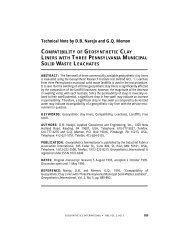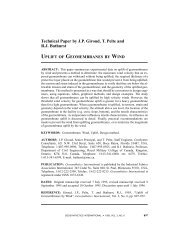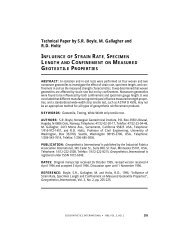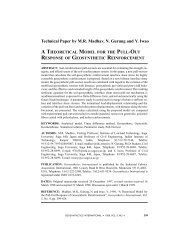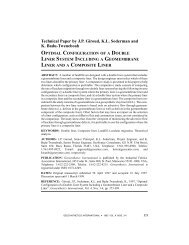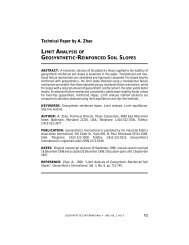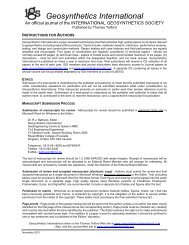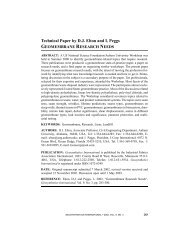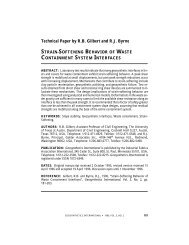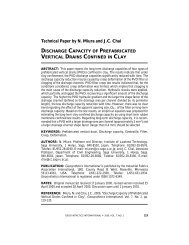Technical Paper by B.C. Rawes - IGS - International Geosynthetics ...
Technical Paper by B.C. Rawes - IGS - International Geosynthetics ...
Technical Paper by B.C. Rawes - IGS - International Geosynthetics ...
Create successful ePaper yourself
Turn your PDF publications into a flip-book with our unique Google optimized e-Paper software.
RAWES D Parameters for Prefabricated Vertical Drain Specification<br />
1 INTRODUCTION<br />
In the last 15 years, prefabricated vertical drains (PVDs) have almost completely replaced<br />
sand drains to accelerate the settlement of clay/silt soils under surcharge loading.<br />
The most important reasons for this change are listed below:<br />
S The installation rate of PVDs is typically 5,000 linear metres per day, which results<br />
in a significantly lower project cost.<br />
S There is no risk of PVDs breaking during installation, while sand drains may have<br />
discontinuities if the mandril is withdrawn too fast.<br />
S There is no risk of shear failure of PVDs during settlement, while sand drains are vulnerable<br />
to shear failure during settlement.<br />
S PVDs have high discharge capacities, typically 30×10 -6 to 90×10 -6 m 3 /s, while a<br />
0.35 m diameter sand drain has a discharge capacity of 20×10 -6 m 3 /s (Van Santvoort<br />
1994).<br />
S When installed with a properly designed mandril, smear effects are much less for<br />
PVDs than for large diameter sand drains. The zone of smear is directly proportional<br />
to the diameter of mandril used for installation.<br />
S PVDs are factory produced materials and are quality controlled, whereas sand drains<br />
are subject to the quality variance of naturally occurring sands.<br />
A generic PVD specification is urgently required in the industry. This is due in large<br />
part to the variable quality of the large number of PVDs available in today’s market.<br />
Many engineers are aware of this problem but may not have an in-depth understanding<br />
of PVDs. Often, engineers over-specify in design, using parameters that are not relevant<br />
to the performance of a PVD, while at the same time not enough attention is given to<br />
the critical parameters. This type of design specification may limit the choice of a PVD<br />
to one or two types that may not be competitive or suitable for the project. In this paper,<br />
the important functions of PVDs are addressed. The paper concludes with a thorough<br />
design specification for the requirements of a high performance PVD.<br />
2 PORE SIZE OF FILTER (GEOTEXTILE)<br />
Prefabricated vertical drains are <strong>by</strong> design, nearly always used in silts or clayey silts<br />
with a D 85 particle size of 15 to 30 µm. Therefore, it is necessary to have a fine pore size<br />
geotextile filter wrapping the core structure that will be compatible with the particle<br />
size distribution of the soil.<br />
There are a large number of geotextile filter criteria put forward in various publications<br />
between 1975 and 1985. This work was reviewed and critiqued <strong>by</strong> Fisher et al.<br />
(1990) and Bergado (1992). Fisher and Bergado have proposed the following criterion<br />
for the maximum pore size of the PVD geotextile filter based on the apparent opening<br />
size (AOS):<br />
AOS ≤ 75 μm<br />
(1)<br />
52 GEOSYNTHETICS INTERNATIONAL S 1997, VOL. 4, NO. 1



